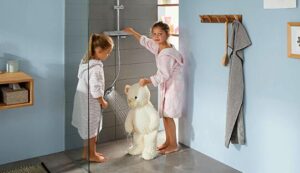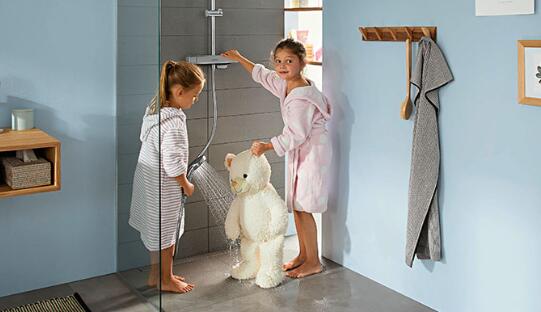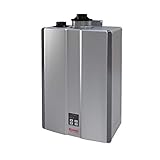Have you considered transitioning from a storage water heater to a tankless water heater for your family? Well, think no more, as going tankless is the way to go. From minimal space wastage to enhanced efficiency, these tankless water heaters will be the most reasonable option for your family.
While choosing the right tankless water heater for your family could be challenging, it is not an impossibility. All you will have to do is to pay attention to critical elements, as discussed here. Here are a few things that you will need to keep in mind when looking for tankless water heaters.
What is the Best Whole House Tankless Water Heater?
- ON/OFF Dial Control with adjustable digital temperature display
- Self-modulating power control
- 24kW Model Flow Rate: up to 5.9 GPM for RTEX-24
- Bottom 3/4" NPT water connections
- On demand, consistent and continuous hot water
How Many Gpm Do I Need for a Whole House Tankless Water Heater?
The flow rate of your tankless water heater will often be measured in gallons per minute (GPM). In most cases, it will vary between 4 and 8 GPM, depending on the temperature rise. It will suffice to mention that the needed flow rate in families will always differ, mostly depending on the number of users.
The average requirement will often be about 5 GPM for a small family. This flow rate will be enough for you if you are brushing your teeth using the hot faucet, a dishwasher, and perhaps a single showerhead. For instance, the tub, shower, and washing machine will need 4, 2.5, and 2 GPM, respectively. That means that the more faucets you intend to use, the higher the GPM should be.

What Size of Tankless Water Heater Do I Need for the Whole House?
As mentioned, the size of tankless water heaters will vary from one house to another, depending on the average usage. That implies that no capacity fits all. Remember, a small size could be inconveniencing for a big family, while a bigger one will end up being costly.
It will suffice to mention that two factors will determine how big your tankless water heater should be. They include the flow rate and the temperature rise.
To determine your ideal flow rate, it will be necessary that you add the flow rate of each appliance you have. For instance, assume that you have a dishwasher, showerhead, and a body sprayer that have rates of 0.5, 2.5, and 2 GPM. Your total flow rate should be at least 5 GPM. As long as you add the GPM from every applicable appliance in your household, you will be sure of the results you so need.
Is It Hard to Install a Tankless Water Heater Where a Tank One Was?
Understandably, you might have reservations about installing a tankless water heater where a tank one was. Thanks to the notion that this installation process could be relatively daunting for you, you might want to refrain. However, this will be wrong.
The installation of tankless water heaters has proven to be relatively straightforward and even less expensive. Whether there was a tank water heater or not, the process is likely to remain the same.
Thanks to its space-saving nature, you will be free to install it anywhere, including where a tank-based water heater cannot fit. The best places for you to fix this device will be in the garage, utility room, attic, and the basement. Regardless of where you choose to install it, the installation process remains the same. Besides, there will be nothing complicating in this process.

How Much Space Is Needed for a Whole House Tankless Water Heater?
One of the biggest concerns when buying a water heater is whether it will fit in your space. Fortunately, this should not be a worry when going for a tankless water heater for your whole house. While it takes little space, it will be vital to understand the exact area you will need in the long run.
Typically, a tankless water heater will need approximately 10000 cubic feet for it to fit correctly. Usually, this space is suitable for tankless water heaters that rely on internal combustion air. Remember, enough space will aid in improving the performance of your heater. It is in this light, still, that you will need to aim at putting the device in an adequately ventilated room.
How to Install Titan N270 Digital Whole House Tankless Water Heater
That this Titan N270 tankless water heater has become relatively popular is something worth celebrating. Its levels of efficiency and unmatched performance have made it a darling to many people. Here are the steps you will observe when installing this digital whole house tankless water heater.
• Shut off the power supply to the unit, including all circuit breakers
• Cut out the primary supply of water
• Take the time to mount the unit on the wall Ensure that the screws are securely in place
• Set the warm and cold connection, preferably using stainless steel flex pipes
• Fix the electrical connections according to the guidelines in the manual, and precisely so
• Turn on the circuit breakers then the water. Now will be the time to check how hot the water is, too
• Confirm whether the hot water outlet needs adjustment. Adjust if necessary
How Big is a Whole House Tankless Water Heater
One of the aspects that attract most people to tankless water heaters is how much space they can save. That implies that these water heaters will hardly be too big to fit your house. Usually, you will be the one to determine which size suits your space better.
Indeed, these tankless water heaters tend to be significantly smaller than the units with storage tanks. It is for this reason that you will comfortably mount them on the wall and even fit them in whatever room you find suitable.
It will suffice to mention that most electric tankless water heaters tend to measure about 10 inches high and 7 inches wide. This kind of size shows just how portable and convenient these units can be, as you will comfortably install them almost anywhere.
In contrast, gas-fired tankless water heaters will come with a height of about 30 inches and a width of around 20 inches. Thanks to the need for space to vent, gas-powered units will always be a little bigger than electric ones. There will also be a need for space within which venting pipes will run.
The size you choose will often have an impact on the ultimate performance of the unit. Most often, the bigger it tends to be, the higher the chances of getting better efficiency levels. However, that should not be the guiding light when looking for one.

How to Size a Whole House Tankless Water Heater
You can hardly run away from the number of users when trying to determine how big your tankless water heater should be. Ideally, the bigger the family, the more likely you will need a bigger tankless water heater. It will suffice to mention that the size of your house and the household are the most significant determinants of aspect. Here is a guide on what you should consider.
• A family of 1 to 2 people
Indeed, a family of two people or less is less likely to require too big a tankless water heater. On average, this household will need a 30-gallon tankless water heater, whether it is powered by gas or electricity. However, if the usage is relatively high, the family will need a 40-50 gallon heater.
- External adjustable digital thermostatic control with LED display (+/1 degree accuracy
- Durable Copper immersion two heating elements, field Serviceable.Self-modulating power control
- Simple installation – 1/2 NPT adapters included; side 1/2 inch Compression water connections
- 99.8% energy efficient. External controls to adjust temperature in increments of 1°f. Water-Saver Shower Head – 1.5 GPM
- Threaded for easy replacement, simple installation, digital temperature display 54 A. 13kW Model Flow Rate: up to 3.17 GPM
- 54 A
• Household of 2-4 people
Typically, a 40 to 50-gallon tankless water heater will be enough for such a household. On the other hand, if they boast of a higher usage rate, the family will need between 50 and 80 gallons.
- Endless Hot Water: Our tankless hot water heaters let you enjoy unlimited hot water flow throughout the house with a compact and durable design that fits your home and lifestyle
- Energy and Space Efficient Tankless Gas Water Heater: This small hot water heater conserves energy, only heating when necessary; Enhanced scale detection lessens possibility of serious, long-term damage to unit
- Optimal Water Pressure: This tankless water heater offers a high-performance hot water flow rate up to 6.5 GPM for a powerful, constant stream that serves up to 5 appliances at once
- Professional Installation Recommended: Visit the Find a Rinnai PRO page on our website to locate a qualified technician in your area to install your tankless water heater; We do not recommend installing a water heater without a technician
- Guaranteed to Last: 10-, 5-, and 1-year residential factory warranty for heat exchanger, labor, and parts, respectively
• Five people and above
Usually, a family of at least five people will need at least 80 gallons. If this household feels that this amount is inadequate, it will be free to consider increasing until attaining the right level.
- Endless Hot Water: Our tankless hot water heaters let you enjoy unlimited hot water flow throughout the house with a compact and durable design that fits your home and lifestyle
- Energy and Space Efficient Tankless Gas Water Heater: This small hot water heater conserves energy, only heating when necessary; Enhanced scale detection lessens possibility of serious, long-term damage to unit
- Optimal Water Pressure: This tankless water heater offers a high-performance hot water flow rate up to 6.5 GPM for a powerful, constant stream that serves up to 5 appliances at once
- Professional Installation Recommended: Visit the Find a Rinnai PRO page on our website to locate a qualified technician in your area to install your tankless water heater; We do not recommend installing a water heater without a technician
- Guaranteed to Last: 10-, 5-, and 1-year residential factory warranty for heat exchanger, labor, and parts, respectively
How to Install a Water Softener into a Whole House Tankless Water Heater
Did you know that softening water will significantly improve the longevity of your tankless water heater? It is in this regard that you will find it valuable to fix a water softener in your device.
Most experts suggest that you install the water softener at the water entry point, especially if you are dealing with a whole-house system. The general rule of the thumb is that this softener has to be at the earliest point in the plumbing system, as this is what assures you of enhanced effectiveness in the long run.
While different water softeners work distinctly, the installation process seems relatively similar. But how do you do it? Here are the steps to the installation of this water softener.
- Switch off the supply of water at the main entry point
- Drain the water lines
- Connect the different functions, as indicated in the manual. You could also install a remote bypass
- Fill your brine tank with water which is half-salt
- Make sure that the bypass is shut before you slowly turn on the water
- Confirm whether there are leaks
- You are now good to go
Recommended Water Softner For Tankless Water Heater
- Whirlpool WHES40E water softener is ideal for households of 1-6 plus people and removes up to 10 ppm of clear water (ferrous) iron
- NSF certified to reduce hard water symptoms such as embarrassing stains, build up on your Plumbing and Faucets and spotting on dishes
- Whirlpool water softeners automatically Calculate how much salt and water is required to regenerate and only uses what is necessary, resulting in a significant reduction in salt and water usage
- Full 1-year parts and labor . The system can be extended to 2 years when you buy 3 bottles of Whirlpool WHEWSC water softener cleanser (sold separately)
- Dimensions: 19" D x 18" W x 47 7/8" H
- Save Money With A 2-in-1 System: Remove hard water minerals and harmful contaminants for families of 1-to-5 with one single-tank system instead of buying 2 separate systems..Rated Service Flow Rate : 8.0 gpm, Maximum Drain Flow Rate : 2 gpm
- Superior Hardness Removal: This hybrid water softener/filter has a 31, 000 grain capacity, an above average hardness removal rating of 120 grains per gallon, and an iron removal rating of 3 ppm which helps reduce reddish-brown stains on drains and water using appliances.
- Water Contaminant Reduction: This whole home filtration system reduces sediment, chlorine taste, and odor from the water used throughout your entire home.
- Efficiently Use Salt: The WHESFC is a smart water softener, meaning it uses demand-initiated regeneration technology to produce soft water as your home needs it, reducing salt costs over the life of the system.
- Designed, engineered and assembled in the USA. Questions Call the Whirlpool helpline
- No Filter to Replace: The WHESFC Pro Series Hybrid cleans its own filter as needed — you will never have to replace the filter.
- Uses up to 25% less salt and water than previous Whirlpool models by monitoring your water usage and only regenerating when necessary. Older timer-based models regenerate on a set cycle regardless of how much water you’ve used; which can result in unnecessary water and salt consumption.
- Connects to plumbing up to 1-1/4″ in diameter. (Connections out of the softener are 1” male pipe threads)
- Whirlpool WHES30E is ideal for households of 1-4 plus people and removes up to 8ppm of clear water (ferrous) iron
- NSF certified to reduce hard water symptoms such as embarrassing stains, build-up on your plumbing and faucets as well as spotting on dishes
- Whirlpool water softeners automatically calculate how much salt and water is required to regenerate and only use what is necessary, resulting in a significant salt and water savings
- Full 1-year parts and labor . The system can be extended to 2 years parts and labor when you buy 3 bottles of Whirlpool WHEWSC water softener cleanser (sold separately)
How Does a Whole-house Tankless Water Heater Work
Typically, whole-house tankless water heaters do not rely on a storage tank when heating water, as the process is usually direct. Once you turn on the hot water tap, cold water flows through a pipe to the unit. It is at this point that the water gets heated, either by natural gas or electric elements. The continuous delivery of heat is indisputable. Here is how each of these types of units works.
• Gas-fired tankless water heaters
In gas-powered units, water flows through a gas heat exchanger, which is responsible for the heating process. This heat exchanger is a series of tubes that pass over gas burners, which then provide the necessary heat. Without this gas heat exchanger, the unit will hardly function.
- Endless Hot Water: Our tankless hot water heaters offer unlimited whole-home hot water flow and come equipped with Circ-Logic for pairing with an external pump to reduce wait time for hot water via scheduled or on-demand recirculation
- Energy and Space Efficient: The tankless design of this small hot water heater saves on space and conserves energy as it heats only when necessary
- Optimal Water Pressure: With a hot water flow rate of up to 11 GPM, this tankless water heater provides a powerful, constant stream that can accommodate up to 7 appliances at once
- Professional Installation Recommended: Visit the Find a Rinnai PRO page on our website to locate a qualified technician in your area to install your water heater; We do not recommend installing a water heater without a technician
- Guaranteed to Last: 15-, 5-, and 1-year residential for heat exchanger, labor, and parts, respectively; Wifi monitoring available with Controlr module (not included)
- ENERGY STAR qualified with Uniform Energy Factor of 0.105
• Electric tankless water heaters
These electric tankless water heaters will often assure you of instant hot water, as they start working once you demand hot water. Thanks to this feature, you can freely refer to them as on-demand units. Its heating process begins as soon as you turn on the faucet. Remember, turning on the heater implies that you are switching on electricity to heat metal coils. As the water flows through the heated metal coils, it gets hot. This process is both fast and more reliable.
- Voltage 240
- Phase Single
- KW 27 kW
- HZ 50/60
- Temperature Control Digital
How to Use a Recirculation Pump in a Whole House Tankless Water Heater
As long as you need to periodically circulate water back to the tankless water heater for heating, you will need a recirculation pump. This recirculation pump comes with a water heater and a pump, which could be either separate or combined. Some pumps are programmable, while others are not.
There are two recirculation methods that you could consider in this regard. It could be a dedicated line for circulation, which means you will have a cold, hot, and recirculation pipe in your system. It only works if the original plumbing system incorporated the recirculation from the onset. However, if it does not have this provision, you can bridge a valve.
Usually, you will rely on either a timer or a thermostat to switch on the pump from time to time. A periodic timer typically comes on after pre-determined durations. In contrast, thermostats will turn on the pump as soon as there is a notable difference in temperature.
How to Vent a Whole House Tankless Water Heater
Unless you understand how to vent your tankless water heater, you will hardly have the experience that you so desire. Here are a few tips to keep in mind.
• Horizontal venting
Here, you could consider installing your vent with a slightly downward slope. It assures you of an adapter as your vent. It will also ensure that the exhaust remains outside the sidewall of your home.
• Vertical venting
This installation will need a ninety-degree elbow, an adapter, and a condensation trap. There must be a firestop too. With this, the installation happens with your vent being relatively upright.
As you look forward to getting hot water in your home, tankless water heaters will be the ultimate choice. As long as you understand how to select the right one, you will always be smiling. With the insights above, you will be confident of not only purchasing the right one but also operating them with ease.











